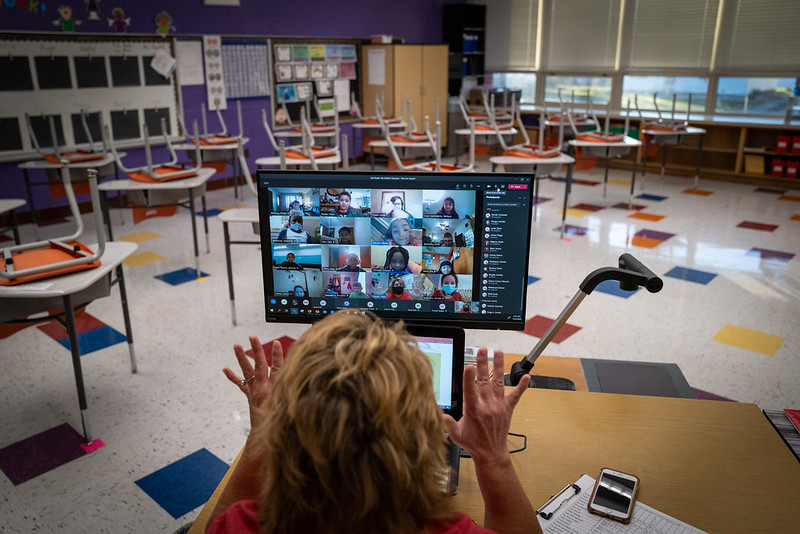Distance learning in Iowa in December 2020. (Phil Roeder / Creative Commons)
It is well known that COVID-19 was largely disastrous for schools, but the numbers behind that claim are still pretty shocking.
There are approximately 1.1 million K-12 students in Washington state public schools, and an estimated 150,000 to 200,000 do not have adequate, reliable Internet access. The state needs 200,000 computers and tablets to give every student access to these important electronics – after federal funds allowed Washington to purchase 64,000 devices last fall.
Half of Washington’s children are on low incomes and 44% are eligible for free or reduced lunches from their school. The digital divide hits these families hardest.
Numerous organizations and initiatives are trying to fill these gaps for students who have reached the one-year mark since schools turned to distance learning.
While those efforts are focused on the here and now, the Seattle-based Technology Alliance announced Tuesday its plan to prepare for the next disaster that will force the school doors to close. In a report entitled “Learning from Calamity”, the non-profit organization providing technical support formulated five key areas:
- Ensure remote internet access for all students and teachers.
- Distribution of a digital learning device to all students and teachers at the beginning of each school year.
- Prepare educators for distance learning and assist districts in creating distance learning plans for each school.
- Providing IT support to educators, students and families.
- Improve communication between schools and families with specific plans for information exchange in the case of distance learning.
Technology Alliance CEO Laura Ruderman acknowledged that it can be difficult to contemplate a future disaster if our lives are still so troubled by COVID, but said it is imperative.
As we wait to act, she said, “We will forget the pain of this moment and it will seem less important to prepare for the next time. We want to use this pressure point to get some momentum for the preparation.
 Laura Ruderman, CEO of the Technology Alliance. (Photo by the Technology Alliance)
Laura Ruderman, CEO of the Technology Alliance. (Photo by the Technology Alliance)
“And if you look at our report, so many of our recommendations to better prepare us for next time have also helped us serve children better today – whether at school or on the go,” said Ruderman.
To produce the document, the Technology Alliance convened a 50-strong task force made up of a who’s who of educators and technology leaders from the Northwest in the public, private, and nonprofit sectors. These included Jessie Wooley-Wilson, CEO of DreamBox Learning, Trish Millines-Dzikoko of the Technology Access Foundation, Russ Elliott, director of the broadband office in Washington, and representatives from Microsoft, Amazon, Google and T-Mobile.
The group spent more than three months in the effort. The measures could also help when students are unable to come to school due to less disastrous causes such as snowy days.
“Children and families in my district and throughout the state are facing the challenges of distance learning – especially in low-income households, in families with blacks and tans, and in families who speak a language other than English. It is our job to address the deep inequalities in our children’s access to quality learning. We need to close the digital divide. “ Task Force member Rep. Mia Gregerson, whose district is in southern King County, said in a statement.
It is our job to address the deep inequalities in our children’s access to quality learning.
The next steps, said Ruderman, will be the most difficult. She hopes to work with either Governor Jay Inslee’s office or the superintendent’s office to put together a blue ribbon commission that can develop a plan for implementing the recommendations.
The report did not include cost estimates for the various initiatives and did not suggest any new sources of funding. About half of the state’s $ 53.3 billion biennial budget is spent on K-12 education, and this year lawmakers must allocate funds to provide economic relief from COVID. Ruderman, who was once a state legislature and served on the state budget-setting committee, was nonetheless hopeful.
“If the legislature decides something is a priority, find out how it can be funded,” she said.
While local tech and telecommunications companies have stepped up their support for schools during the COVID crisis, Ruderman is not in favor of selectively persuading the sector or its employees to donate equipment or carry taxes that are specifically aimed at them.
“I hope that legislators will take a holistic look at funding needs and that the various sectors of our business world will also take a look. and whatever sector we are in, we will all find out how to carry our fair share of the collective burden, ”said Ruderman.
